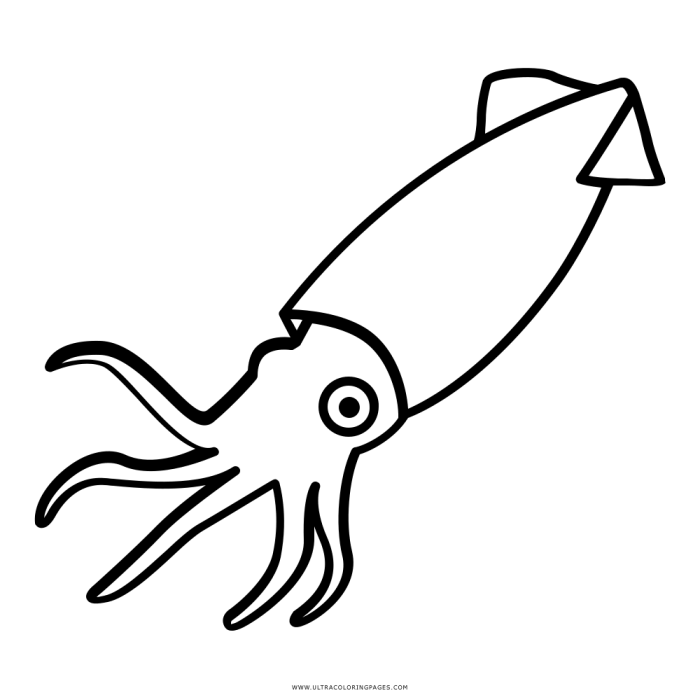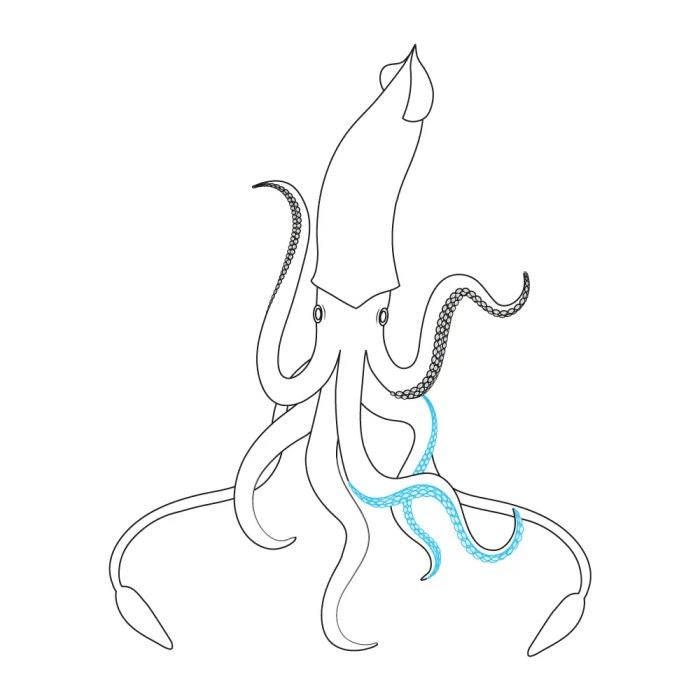Drawing of a Squid Easy A Beginners Guide

Understanding Basic Squid Anatomy for Drawing: Drawing Of A Squid Easy

Drawing of a squid easy – A creature of the deep, the squid, a phantom of shifting shadows and inky escape, yields its secrets reluctantly to the artist’s gaze. To capture its essence, a careful study of its form is required, a melancholic pursuit of understanding its fleeting beauty. Its anatomy, a symphony of fluid motion and sudden bursts of speed, holds the key to a truly evocative portrayal.The squid’s body, a testament to the ocean’s artistry, is a fascinating blend of elegance and power.
Its fundamental components are crucial to understanding its movement and form, each part contributing to its unique silhouette.
Squid Body Components
The mantle, the squid’s main body, is a muscular, elongated structure that houses its vital organs. It’s the largest part of the squid, often tapered at both ends, and is the foundation upon which the rest of its body is built. From this central form, the fins, two triangular structures near the mantle’s posterior, provide propulsion and steering.
They are delicate, almost fragile in appearance, contrasting sharply with the powerful mantle. The tentacles, eight arms, and two longer tentacles are attached to the anterior end of the mantle, each playing a crucial role in locomotion, feeding, and defense. Finally, the eyes, large and expressive, are positioned on the anterior side of the mantle, observing the deep, mysterious world around them.
Distinguishing Tentacles and Arms, Drawing of a squid easy
The squid’s tentacles and arms, though both appendages, possess distinct characteristics. The eight arms are shorter, covered in suckers, and primarily used for grasping prey and manipulating objects. In contrast, the two longer tentacles, often with clubs at their tips, are specialized for capturing prey from a distance. These tentacles shoot out with surprising speed, securing the victim before being retracted, bringing the meal within reach of the shorter arms.
The difference in length and sucker arrangement provides a visual distinction, vital for accurate depiction.
Squid Skin Texture and Shape
The squid’s skin is remarkably smooth, almost silken to the touch, though its appearance can vary greatly depending on the species and its surroundings. It’s often described as having a slightly rubbery texture, capable of changing color and pattern through the manipulation of specialized pigment cells called chromatophores. This ability to camouflage is essential for survival, allowing the squid to blend seamlessly into its environment.
The overall shape of the squid, however, tends towards an elongated, torpedo-like form, streamlined for efficient movement through the water.
Simplified Internal Structure
Imagine a simple diagram: a central oval representing the mantle, containing smaller, less defined shapes suggesting the internal organs. A few lines extending from the oval represent the arms and tentacles, terminating in small circles to indicate the suckers. Two smaller, triangular shapes attached to the rear of the oval depict the fins. The eyes are represented by two simple circles positioned on the front of the mantle.
This rudimentary sketch captures the essence of the internal structure without unnecessary detail, highlighting the relationship between the external and internal components. This simplicity allows the artist to focus on the fluidity of the external form.
Drawing a squid? Super easy, right? Just a few curves and tentacles. It’s a total vibe shift from something like a 22nd amendment cartoon easy drawing , which requires a bit more political savvy (and maybe some knowledge of US history!). But hey, both are chill projects for a relaxed afternoon – after all, even squids deserve some artistic love.
Simplified Drawing Techniques

A silent canvas, a whispered plea, the cephalopod’s form, for all to see. Let’s capture its essence, a fleeting grace, with simple shapes and a gentle pace. We’ll tame the complexity, find beauty untold, in strokes that are fluid, stories unfold.
This section details a simplified approach to drawing squid, focusing on basic shapes and techniques accessible to all skill levels. We will transform the intricate anatomy into manageable forms, allowing for expressive artistic freedom.
Squid Body Construction Using Basic Shapes
Begin with a slightly elongated oval for the squid’s mantle. This forms the main body. Attach a smaller, slightly flattened circle to one end of the oval; this will be the head. From the head, extend a series of gently curving lines to represent the tentacles, keeping them fluid and organic. Remember, we are seeking a representation, not a precise anatomical replica.
The melancholy of the deep hangs heavy in each curve.
Methods for Drawing Squid Eyes
Three approaches to capturing the squid’s enigmatic gaze are presented here. Each method allows for a different level of detail and expression, reflecting the mood of the artist and the depth of the ocean.
Method 1: A simple, dark circle. This minimalistic approach conveys the essence of the eye without elaborate detail. The darkness mirrors the unfathomable depths.
Method 2: A slightly larger circle with a smaller, lighter circle within it to suggest a highlight. This adds a touch of realism and dimension, a glimmer in the inky black.
Method 3: A detailed eye, incorporating a pupil, iris, and a subtle reflection. This method provides a more realistic rendering, but requires more precision and attention to detail. The reflection hints at a world unseen, a secret held within the depths.
Drawing Squid Tentacles Using Flowing Lines and Curves
The tentacles, so vital to the squid’s character, are best rendered with fluid lines. Avoid rigid straight lines; instead, opt for flowing curves that mimic the movement and flexibility of the real thing. Think of them as graceful ribbons dancing in the currents. Each curve tells a story of the ocean’s ebb and flow, a tale of silent movement.
Begin by sketching several gently curving lines emanating from the head. Vary the lengths and curves to create a sense of natural movement. Thicken the lines near the head and gradually taper them towards the ends. Add subtle details such as suckers using small circles or dots along the tentacles. The gentle undulations evoke a sense of longing, a quiet desperation.
Creating Shading and Texture for Depth
Shading is crucial for adding depth and realism to the drawing. Begin by identifying the light source. Use darker tones on the sides and underside of the squid to create shadows and emphasize its three-dimensionality. Use lighter tones to highlight areas that would be directly exposed to light. The subtle play of light and shadow hints at the hidden life beneath the waves.
To add texture, use light hatching or cross-hatching to create the impression of skin. Focus on areas where the skin might appear rougher or more textured. The subtle variations in tone create a sense of movement, a life barely contained.
FAQ Resource
What kind of paper is best for drawing squids?
Smooth drawing paper works well for beginners, allowing for easy corrections. Heavier weight paper (at least 90lb) is recommended to prevent ink bleed-through.
What are some common mistakes to avoid when drawing squid tentacles?
Avoid making tentacles too stiff or uniform. Focus on creating flowing, organic curves and variations in thickness to achieve a more realistic look.
Can I use digital tools to draw squids?
Absolutely! Digital drawing programs offer a wide range of tools and brushes for creating detailed and expressive squid drawings.
How can I add more personality to my squid drawings?
Consider the squid’s pose, expression (in the eyes!), and surrounding environment to convey a sense of personality. A playful pose will convey a different feeling than a menacing one.

